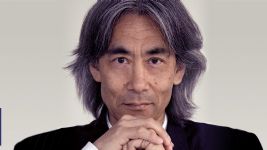|
Chamber
FAMILIAR AND NEW - TRIO NAVARRO'S SPRING CONCERT IN WEILL
by Terry McNeill
Sunday, April 21, 2024
Symphony
MONUMENTAL MAHLER 5TH IN SO CO PHIL'S SEASON ENDING CONCERT
by Terry McNeill
Sunday, April 14, 2024
Chamber
OAKMONT SEASON CLOSES WITH STRAUSS' PASSIONATE SONATA
by Terry McNeill
Thursday, April 11, 2024
Chamber
MORE GOLD THAN KORN AT ALEXANDER SQ CONCERT
by Terry McNeill
Sunday, April 7, 2024
Choral and Vocal
VIBRANT GOOD FRIDAY REQUIEM AT CHURCH OF THE ROSES
by Pamela Hicks Gailey
Friday, March 29, 2024
TWO OLD, TWO NEW AT THE SR SYMPHONY'S MARCH CONCERT IN WEILL
by Peter Lert
Saturday, March 23, 2024
Chamber
NOT A SEVENTH BUT A FIRST AT SPRING LAKE VILLAGE CONCERT
by Terry McNeill
Wednesday, March 20, 2024
THIRTY-THREE PLUS VARIATIONS AND AN OCEAN VIEW
by Terry McNeill
Saturday, March 16, 2024
Choral and Vocal
A ST. JOHN PASSION FOR THE AGES
by Abby Wasserman
Friday, March 8, 2024
Choral and Vocal
SPLENDID SCHUBERT SONGS IN SANET ALLEN RECITAL
by Terry McNeill
Saturday, March 2, 2024
|
 |
 Conductor Kent Nagano |
CENTURY-OLD MUSIC REMAINS EXPLOSIVE IN EXTRAVAGANT WEILL CONCERT PERFORMANCE
by Nicki Bell
Friday, March 25, 2016
A spectacular performance of Debussy, Prokofiev and Stravinsky with a virtuoso orchestra and a brilliant pianist will long be remembered by the fortunate 1,000 in Weill Hall March 25. The Orchestre Symphonique de Montreal itself is huge, nearly 110 musicians, and it completely filled the stage and risers. The black outlines of two exquisite-looking harps, art nouveau furniture pieces in exotic woods, added a skyline above the violins. Kent Nagano, a precise and elegant conductor, drew a gorgeous and clear sound from the players throughout.
This was a fascinating program, the pieces all avant-garde in their time and still sound relevant today, and were composed roughly a century ago. Debussy’s Jeux opened, followed by Prokofiev’s C Major Concerto (No. 3) with the remarkable young Russian pianist Daniil Trifonov. Stravinsky’s Rite of Spring (Sacre du Printemps) was the expected powerful second half. Both Jeux and Rite were composed for Serge Diaghilev’s Ballets Russes, and choreographed by Vaslav Nijinsky and premiered within weeks of each other in Paris in 1913.
Jeux depicts a garden at night (the ballet drew on golf, tennis and jazz postures and was not a hit) with short musical themes, one quickly following another, clarinets and harps opening the curtains on the bushes and brambles, light playing on leaves, a bouncing ball. A painting in sound, strokes of color, washes in sound that can trigger the imagination. The woodwinds called forth a playfulness in the music. Exquisite playing.
Prokofiev first started working on this Concerto while still a student at the St. Petersburg Conservatory, and completed the work in 1921 and performed the solo part in Chicago the same year. A virtuoso pianist, the composer could play the herculean technical challenges he had written as of course Mr. Trifonov did here. The opening notes of clarinet merged with a lyrical and meandering string quality, and then the driving orchestra hijacks everything. These clarinet melodic notes become motovic material for the movement, and when the second theme joins both they were deftly enlarged and shaped by Mr. Nagano.
A theme and variations second movement brings out opposing character in the same musical material, and there is humor here as well as lush lyricism. The ostensibly quiet soloist had an animal character, moving like a cat stroking the keys and then mastering terrifying and crazy double octaves up and down the keyboard with joyful exuberance. He seemed to bounce up and down, his nose inches from the piano keys.
The third movement is a tour de forces with long legato string lines to a hair-raising coda that increased in energy with insistent orchestra rhythms, and the pianist played hand-over-hand until his digits became a blur. The audience of course went wild and the artist returned to the stage to play an outrageous and marvelous transcription of the Johann Strauss Overture to the opera “Die Fledermaus.” Mr. Trifonov is a mesmerizing pianist, part Liszt and part Glenn Gould, and his technique is off the charts, albeit with depth and sensitivity. Still at the beginning of a big career, he is also an upcoming composer.
As though this drama wasn’t sufficient, in the second half Stravinsky’s seminal work still shocks after a century. Inaugurating a new era in music, the performance riot it caused at the Paris opera is legendary. At that debut the audience outrage was so loud and prolonged that the onstage dancers could not hear the orchestra. The frenetic and propulsive score depicts a series of scenes from pagan rituals around the coming of spring, culminating in a chosen maiden dancing to her death. There are Russian folk tunes, incessant driving rhythms and potent syncopation that create a pulsating, throbbing machine of sound.
It was a perfect vehicle for admiring the resplendent Montreal ensemble’s mighty sonority, and under Mr. Nagano’s direction the piece never went off the tracks. It is a signature work for this orchestra, performed constantly for fifty years with many conductors.
The audience kept bringing Mr. Nagano back so often that he responded by leading two encores, the first being Debussy’s “Prelude de l’apres-midi d’un Faune.” It was lovely and seemed to have been waiting in the wings since Jeux. The playing of the solo flutist was captivating, setting the melodic tone as did clarinets in the Prokofiev and bassoons, clarinets and horns in Sacre. Peaceful and lush, it calmed the hall. Finally the concert closed with the delight of Bizet’s Suite No. 1 from the long forgotten stage play “L’Arlesienne.”
It was a stunning musical evening.
|

